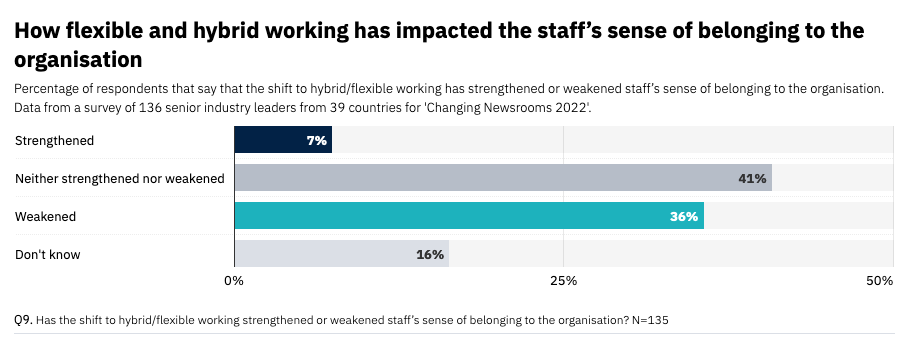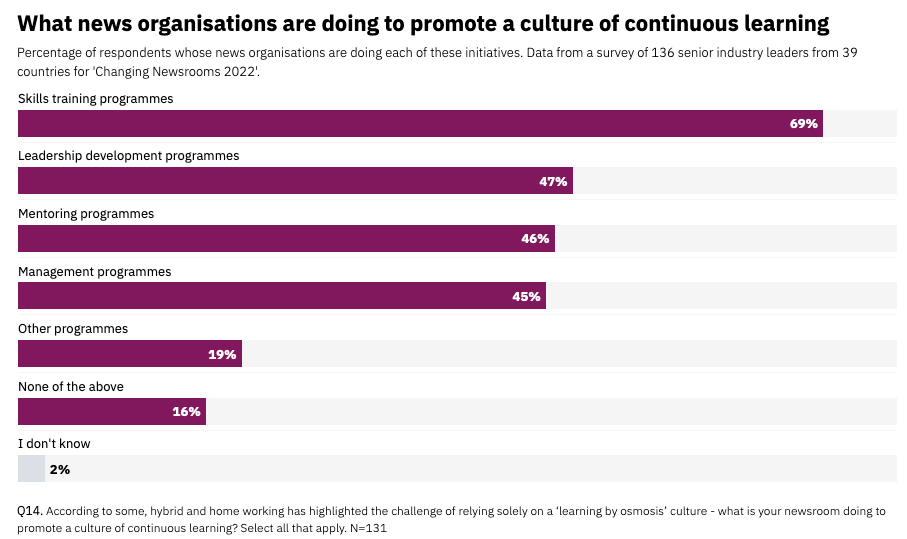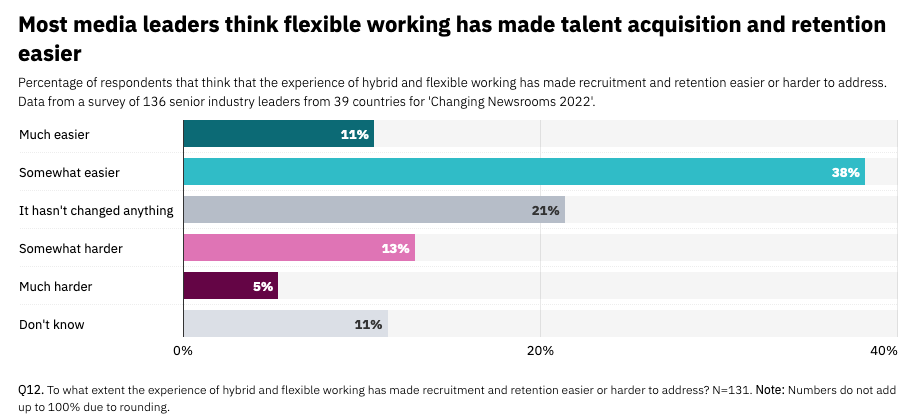
Most news organisations are becoming hybrid workplaces, as a middle ground between commuting into the office or working from home.
Research from the Reuters Institute for the Study of Journalism (RISJ) found that nearly two thirds (61 per cent) of news organisations are formally committed to a hybrid newsroom - a model of two or three days in the office, and the rest at home. The data is based on a survey of 136 senior industry leaders from 39 countries and a series of in-depth interviews.
This is a decline from the 79 per cent of organisations who were "on board" with hybrid last year, but hybrid is still emerging as the direction of travel for newsrooms. The difference is now this commitment is part of formal work policies.
Pre-pandemic, commuting to the office was the norm, albeit exhausting and expensive one. Lockdown forced everyone to the other extreme, working in isolation and missing out on the camaraderie of a newsroom.
It seems that hybrid is the "best of both worlds", suggests the author and newly-promoted director of leadership development, RISJ, Federica Cherubini, speaking on the Journalism.co.uk podcast.
Natalia Uval, editor-in-chief of Uruguay's La Diaria said in the report: "I think we are doing a good job because we take good things of virtual working (effectiveness, punctuality, comfort) and good things of face-to-face work (human interaction, discussions, collective construction)."
Hybrid means that journalists can more easily juggle their responsibilities at home. But concerns around it remain.
Productivity: a help or hindrance?
Does flexibility translate to efficiency? Does hybrid provide more distractions than freedom? The answer is not clear, as nearly half (45 per cent) say productivity has been neither good nor bad.
There are probably no silver bullets here. Instead, this is where newsrooms should seek to test and evolve to find the sweet spot for their news operation.

Screenshot: RISJ Changing Newsrooms 2022
Take policies, for example, on attendance in the newsroom. Half of organisations have set a compulsory, minimum number of days to come into work, whereas 29 per cent have a voluntary minimum number of in-person days.
UK news publisher DC Thomson has been experimenting within two of its Scottish newsrooms, one with a fixed mandate and the other with a flexible one. It has been using surveys to gauge how different policies are received and enforced. It has not yet settled on a default model.
Disconnection or democratisation?
Newsroom leaders feel more connected with their immediate teammates because of hybrid, but there is a general disconnect between the fringes of the newsroom and the top management.
The isolation of working from home was one of the main concerns during the pandemic and it has not gone away. One third of survey respondents say they are worried about a weakened sense of belonging even with hybrid work models.

Screenshot: RISJ Changing Newsrooms 2022
A powerful counterargument is that the virtual working environment has democratised work calls. As Cherubini explains: "We are all squares on Zoom and you might be a square next to the CEO of your company whereas before you might not have taken that seat in the big meeting with the CEO."
It all depends on the organisation and its culture. What the research shows is that the pandemic has produced imbalanced connections across the company. This is where many organisations have been proactive: roughly three quarters have already invested in new digital technology for hybrid meetings and half have redesigned office space to accommodate hybrid work.
The burden of leadership
The pandemic, generally, has placed greater emphasis on mental health, work-life balance and job satisfaction - as far as to embolden people to follow the 'quiet quitting' trend (performing to the minimum of contractual obligations).
Presenteeism would be the reverse, defined as showing up for work even when not feeling physically or mentally up to the task. It would be a mistake to think this has not carried forward into the hybrid work world.
"One way to show you are working is you have a green dot on Slack," says Cherubini. The question for newsroom leaders is this: how are work and success measured in this new world? The challenges of smoothly implementing hybrid are ultimately managerial.
Cherubini cites a piece by the Harvard Business Review on the performance-compassion dilemma weighing on managers: they are trapped between delivering on the demands from above, all while soaking up the pressure and protecting those beneath them. The knock-on effect is one of burnout in newsroom leaders.
Developing the next stars
It is a myth that flexible and hybrid work stunts the growth of young staff. The well-trodden path in newsrooms is to turn to seasoned colleagues for advice or "learn via osmosis" when the news is unfolding in real time. That is much harder to achieve when connected from afar.
However, newsrooms have been able to compensate by providing mentorship, learning or development programmes from a distance. This is also useful for older journalists looking to acquire new skills.
It is harder to enforce remotely too, as it can quickly become a justification of staffing and resources, and be disproportionately harder for junior staff with less convenient work setups at home.

Screenshot: RISJ Changing Newsrooms 2022
Perhaps the answer lies in incentivising staff to come in, whether specifically for learning days or more social events, like pizza days. The jury is out here, as 39 per cent of newsrooms say they are struggling to convince staff to come in, and 38 per cent say they are not.
A competitive advantage?
The advantage of hybrid is that it promises greater diversity of hires in editorial departments and especially when it comes to hiring outside of the immediate geographical remit. For metropolitan-based organisations, we can hire applicants who cannot afford to, or do not want to, live in the big cities.
For now, offering hybrid work is still just a competitive advantage when hiring. But that could change as hybrid becomes more commonplace. The likelihood is that hybrid will become less of a perk, and more of an expectation.

Screenshot: RISJ Changing Newsrooms 2022
For the 17 per cent of organisations currently unable to adapt or unsure how to implement hybrid, or the 20 per cent who largely want to return to the status quo of nine-to-five in the office, will they miss out on the best talent?
That really varies in different parts of the world, where there are different cultures around the flexibility of work, or where unions may need to be involved to renegotiate contracts.
Cherubini's takeaway from the research is this: evaluate what rule you are choosing and why. Communicate to your staff why this decision has been made and what is in it for them.
"The worst possible scenario is forcing people to come back to just sit on Zoom all day because they have two colleagues in person and four online. So why have they commuted if you would have had the same day at home?"
Free daily newsletter
If you like our news and feature articles, you can sign up to receive our free daily (Mon-Fri) email newsletter (mobile friendly).
Related articles
- Recruiting for inclusion: a guide for media organisations
- RISJ Digital News Report 2024: User needs with Vogue and The Conversation
- RISJ Digital News Report 2024: Three essential points for your newsroom
- RISJ Digital News Report 2024: Five trends to watch in the UK
- 'My colleagues helped me through the hardest story of my career'









